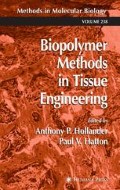Abstract
Tissue engineering is a major focus of biotechnological research today, with the expectation that this type of technique will ultimately transform medical practice (1). The most ambitious tissue-engineering schemes assume that specific tissues and organs will be restored, in a multistage fabrication procedure. For example, cells derived from the patient may be processed to increase the total number available, seeded into a suitable three-dimensional (3D) resorbable scaffold and further processed in vitro to induce the elaboration of neo-tissue prior to implantation (2).
Access this chapter
Tax calculation will be finalised at checkout
Purchases are for personal use only
References
Nerem, R. M. (2000) Tissue engineering: confronting the transplant crisis. Proc. Inst. Mech. Engrs. Part H, 214, 95–99.
Bader, D. L. and Lee, D. A. (2000) Structure-properties of soft tissues: articular cartilage, in Structural Biological Materials: Design and Structure Property Relationships (Elices, M., ed.), Oxford, UK, Pergamon Press, pp. 73–104.
Ateshian, G.A., Soslowsky, L. J., and Mow, V. C. (1991) Quantitation of articular surface topography and cartilage thickness in knee joints using sterophotogram-metry. J. Biomechanics 24, 761–776.
Enobakhare, B., Bader, D. L., and Lee, D. A. (2001) Physiochemical, biochemical and mechanical characterisation of chondrocyte/alginate constructs. Trans. Orthop. Res. Soc. 26, 638.
Wu, F., Dunkelman, N., Peterson, A., Davisson, T., De La Torre, R., and Jain, D. (1999) Bioreactor development for tissue-engineered cartilage. Ann. NY Acad. Sci. 875, 405–411.
Obradovic, B., Carrier, R. L., Vunjak-Novakovic, G., and Freed, L. E. (1999) Gas exchange is essential for bioreactor cultivation of tissue engineered cartilage. Biotechnol Bioeng. 63, 197–205.
Huang, D., Chang, T. R., Aggarwal, A., Lee, R. C., and Ehrlich, H. P. (1993) Mechanisms and dynamics of mechanical strengthening in ligament-equivalent fibroblast-populated collagen matrices. Ann. Biomed. Eng. 21, 289–305.
Freed, L. E., Vunjak-Novakovic, G., Biron, R.J., Eagles, D. B., Lesnoy, D. C., Barlow, S. K., et al. (1994) Biodegradable polymer scaffolds for tissue engineering. Biotechnology 12, 689–693.
Paige, K. T., Cima, L. G., Yaremchuk, M. J., Schloo, B. L., Vacanti, J. P., and Vacanti, C. A. (1996) De novo cartilage generation using calcium alginate-chondrocyte constructs. Plast. Reconstr. Surg. 97, 68–78.
Begley, C. M. and Kleis, S. J. (2000) The fluid dynamic and shear environment in the NASA/JSC rotating-wall perfused-vessel bioreactor. Biotechnol. Bioeng. 70, 32–40.
Vunjak-Novakovic, G., Martin, I., Obradovic, B., Treppo, S., Grodzinsky, A. J., Langer, R., et al. (1999) Bioreactor cultivation conditions modulate the composition and mechanical properties of tissue-engineered cartilage. J. Orthop. Res. 17, 130–138.
Martin, I., Obradovic, B., Treppo, S., Grodzinsky, A. J., Langer, R., Freed, L. E., et al. (2000) Modulation of the mechanical properties of tissue engineered cartilage. Biorheology 37, 141–147.
Lee, D. A. and Bader, D. L. (1997) Compressive strains at physiological frequencies influence the metabolism of chondrocytes seeded in agarose. J. Orthop. Res. 15, 181–188.
Lee, D. A., Noguchi, T., Frean, S. P., Lees, P., and Bader, D. L. (2000) The influence of mechanical loading on isolated chondrocytes seeded in agarose constructs. Biorheology 37, 149–161.
Vunjak-Novakovic, G., Obradovic, B., Martin I., Bursac, P. M., Langer, R., and Freed, L. E. (1998) Dynamic cell seeding of polymer scaffolds for cartilage tissue engineering. Biotechnol. Progr. 14, 193–202
Freed, L. E., Hollander, A. P., Martin I., Barry, J. R., Langer, R., and Vunjak-Novakovic, G. (1998) Chondrogenesis in a cell-polymer-bioreactor system. Exp. Cell Res. 240, 58–65.
Author information
Authors and Affiliations
Editor information
Editors and Affiliations
Rights and permissions
Copyright information
© 2004 Humana Press Inc.
About this protocol
Cite this protocol
Lee, D.A., Martin, I. (2004). Bioreactor Culture Techniques for Cartilage-Tissue Engineering. In: Hollander, A.P., Hatton, P.V. (eds) Biopolymer Methods in Tissue Engineering. Methods in Molecular Biology™, vol 238. Humana Press. https://doi.org/10.1385/1-59259-428-X:159
Download citation
DOI: https://doi.org/10.1385/1-59259-428-X:159
Publisher Name: Humana Press
Print ISBN: 978-0-89603-967-4
Online ISBN: 978-1-59259-428-3
eBook Packages: Springer Protocols

